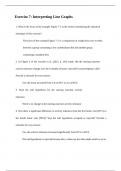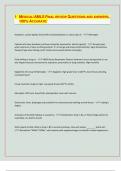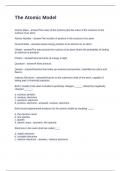Intermediate financial accounting summary
Lecture 1. Financial reporting, IFRS development, and conceptual framework
Financial accounting: a collection and processing of financial information to meet the
decision-making needs of parties external to the organization. The information is regulated.
Management accounting: a collection and processing of financial (and non-financial)
information to meet the decision-making needs of parties internal to the organization. The
information is not regulated at all.
Accounting information system: collect and processes transaction data and them
disseminates the financial information to interested parties.
Double-entry accounting system: a company records the dual (two-sided) effect of each
transaction in appropriate accounts.
Role of financial reporting
Economic (theory) reasoning:
- Firm need economic resources (capital providers)
- Absence of reporting= wild wild west! → adverse selection
- For an efficient functioning→ capital providers write contracts to prevent agency
conflict and moral hazard behavior
Annual report vs. Financial statements
Difference is that annual report is voluntary document that is unregulated
- General non-standard summary of company activities
- It includes financial statements, but many other things (e.g. CEO letter, employee
and gender issues, operation improvements, new technological developments,…)
- Distributed through media, firm websites,…
Financial statements are regulated by Generally Accepted Accounting Principles (GAAP). The
statements must be deposited in national registers Chamber of commerce (KvK) in the NL.
They comply with accounting standards. They usually including of all financial statements
and notes, depending on firm characteristics (big company usually need to provide more
information than smaller company).
The financial statements are:
- Statement of financial position (aka balance sheet)
- (comprehensive) income statement (aka P&L)
- Statement of cash flows
- Statement of changes in shareholders’ equity
- Notes→ information on the criteria, principles of equity and the changes during the
last year
Role of financial reporting standards
,To satisfy the need for financial reporting, government establish a set of rules (GAAP). A lot
of developed countries have their own accounting standards:
- US GAAP
- UK GAAP
- Plan General de Compabilite (France)
- Plan General Contable (Spain)
But a need for an international set of rules was obvious→ International Financial Reporting
Standars (IFRS):
- High-quality
- Understandable
- Enforceable
- Globally accepted
- Comparable
The objective (purpose) of financial reporting: to provide financial information about the
reporting entity that is useful to present and potential equity investors, lenders, and other
creditors in making decisions about providing resources to the entity.
Entity perspective: Companies are viewed as separate and distinct form their owners
(present shareholders). The assets are viewed as assets of the company and not of a specific
creditor or shareholders.
Development of IFRSS
Some countries came with the idea to
convert all the domestic standards to an
international standard→ IASC was
founded in 1973. In 2001 the IASC became
the IASB (international accounting
standards board). The IASB is in charge of
developing the new international
standards (IFRS).
From 1997-2002 there was the SIC
(Standards Interpretations Committee)
which comments on the standards set by
the IASC. From 2002, the SIC became IFRIC
(International Financial Reporting
Interpretations Committee). IFRIC
comments on the IASB standards
The International Organization of Securities Commissions (IOSCO): an association of
organizations that regulate the world’s securities and future markets. The organization is
dedicated to ensuring that the global markets can operate in an efficient and effective basis.
,IASB Due Process (“approval’’ of a standard)
Standard setting through open due process:
- The IASB establish and Advisory Council to give advice on issues arising from a
project
- Continual consultation between IASB and the IFRSs Advisory Council occur
throughout the process
- Discussion documents are prepared for public consultation
- Comments are received and reviewed. IASB prepares and publish an Exposure Draft
for public comment (approval by 9 IASB members required)
- Comments are received and reviewed. IASB issues final draft
- Standards are published with basis for conclusion to assets users in their application
Conceptual framework
- A baseline
- A layout
- A starting point
- Fundamental concepts
Purpose a conceptual framework
It establishes the “big picture”, but if some standard is contrary to it, the standard prevails.
It contains several subchapters:
- Chapter 1. Objective of financial reporting
o Provide financial information about the reporting entity that is useful to
present and potential equity investors, lenders, and other creditors in
deciding
▪ Buying, selling, holding a stock/ settling credit with the firm/voting
o to make such decisions, users assess
▪ entity’s ability to generate future cash flows
▪ management stewardship: how well mangers use company’s
resources
- chapter 2. Qualitative characteristics of financial information
, o what (financial) information should firms report?
▪ Should I report an “unusual
gain” separately in my P&L?
Choose the alternative that provides the most
useful information for decision-making. To be
useful, information needs to meet 2
fundamental qualities:
1. Relevance: information is predictive of firm
value (users can correctly infer future cash
flows), and material (users would be
affected if omitted)
2. Faithful representation: information is
complete, neutral (“good and bad” news
included) and free from error
When relevance and faithful representation are present, other information qualities
enhance the usefulness of accounting information:
- Comparability: comparable within firm (over time) and across firms
- Verifiability: information is verifiable by several third parties (e.g. 2+ auditors)
- Timeliness: be presented on time for decision-making
- Understandability: set out as clearly and concisely as possible
- Chapter 3. Financial statement and the reporting entity
o Financial statement should include
▪ Statement of financial positions (assets, liabilities and equity)→ BS
▪ Statement of financial performance (income and expenses)→ PL, IS
▪ And “other” statements
• Unrealized revenues/expenses/gains/losses- excluded from PL
(other comprehensive income OCI)
• Cash flows (CF statement)
• Contributions/distributions to equity holders (equity
statement)
• Methods, assumptions, judgements, and changes (notes)
o FS are presented under the assumption of a going concern (business will not
go bankrupt in a going of month)
▪ Many assets= Acquisition cost→ if liquidation is imminent; market
values
▪ Depreciations consider years of useful life
o Reporting entity is an entity who prepares FS. It can be:
▪ Single entity: one company
▪ A portion of an entity: one division/segment
▪ More than one entity: a parent with subsidiaries
o Depending on reporting entity, one will prepare:
▪ Consolidated FS: parent + subsidiaries reporting as a single entity
▪ Unconsolidated FS: parent or subsidiary alone provides FS
▪ Combined FS: reporting entity comprises +2 entities not linked by
parent subsidiary relationship (e.g. joint venture)
Lecture 1. Financial reporting, IFRS development, and conceptual framework
Financial accounting: a collection and processing of financial information to meet the
decision-making needs of parties external to the organization. The information is regulated.
Management accounting: a collection and processing of financial (and non-financial)
information to meet the decision-making needs of parties internal to the organization. The
information is not regulated at all.
Accounting information system: collect and processes transaction data and them
disseminates the financial information to interested parties.
Double-entry accounting system: a company records the dual (two-sided) effect of each
transaction in appropriate accounts.
Role of financial reporting
Economic (theory) reasoning:
- Firm need economic resources (capital providers)
- Absence of reporting= wild wild west! → adverse selection
- For an efficient functioning→ capital providers write contracts to prevent agency
conflict and moral hazard behavior
Annual report vs. Financial statements
Difference is that annual report is voluntary document that is unregulated
- General non-standard summary of company activities
- It includes financial statements, but many other things (e.g. CEO letter, employee
and gender issues, operation improvements, new technological developments,…)
- Distributed through media, firm websites,…
Financial statements are regulated by Generally Accepted Accounting Principles (GAAP). The
statements must be deposited in national registers Chamber of commerce (KvK) in the NL.
They comply with accounting standards. They usually including of all financial statements
and notes, depending on firm characteristics (big company usually need to provide more
information than smaller company).
The financial statements are:
- Statement of financial position (aka balance sheet)
- (comprehensive) income statement (aka P&L)
- Statement of cash flows
- Statement of changes in shareholders’ equity
- Notes→ information on the criteria, principles of equity and the changes during the
last year
Role of financial reporting standards
,To satisfy the need for financial reporting, government establish a set of rules (GAAP). A lot
of developed countries have their own accounting standards:
- US GAAP
- UK GAAP
- Plan General de Compabilite (France)
- Plan General Contable (Spain)
But a need for an international set of rules was obvious→ International Financial Reporting
Standars (IFRS):
- High-quality
- Understandable
- Enforceable
- Globally accepted
- Comparable
The objective (purpose) of financial reporting: to provide financial information about the
reporting entity that is useful to present and potential equity investors, lenders, and other
creditors in making decisions about providing resources to the entity.
Entity perspective: Companies are viewed as separate and distinct form their owners
(present shareholders). The assets are viewed as assets of the company and not of a specific
creditor or shareholders.
Development of IFRSS
Some countries came with the idea to
convert all the domestic standards to an
international standard→ IASC was
founded in 1973. In 2001 the IASC became
the IASB (international accounting
standards board). The IASB is in charge of
developing the new international
standards (IFRS).
From 1997-2002 there was the SIC
(Standards Interpretations Committee)
which comments on the standards set by
the IASC. From 2002, the SIC became IFRIC
(International Financial Reporting
Interpretations Committee). IFRIC
comments on the IASB standards
The International Organization of Securities Commissions (IOSCO): an association of
organizations that regulate the world’s securities and future markets. The organization is
dedicated to ensuring that the global markets can operate in an efficient and effective basis.
,IASB Due Process (“approval’’ of a standard)
Standard setting through open due process:
- The IASB establish and Advisory Council to give advice on issues arising from a
project
- Continual consultation between IASB and the IFRSs Advisory Council occur
throughout the process
- Discussion documents are prepared for public consultation
- Comments are received and reviewed. IASB prepares and publish an Exposure Draft
for public comment (approval by 9 IASB members required)
- Comments are received and reviewed. IASB issues final draft
- Standards are published with basis for conclusion to assets users in their application
Conceptual framework
- A baseline
- A layout
- A starting point
- Fundamental concepts
Purpose a conceptual framework
It establishes the “big picture”, but if some standard is contrary to it, the standard prevails.
It contains several subchapters:
- Chapter 1. Objective of financial reporting
o Provide financial information about the reporting entity that is useful to
present and potential equity investors, lenders, and other creditors in
deciding
▪ Buying, selling, holding a stock/ settling credit with the firm/voting
o to make such decisions, users assess
▪ entity’s ability to generate future cash flows
▪ management stewardship: how well mangers use company’s
resources
- chapter 2. Qualitative characteristics of financial information
, o what (financial) information should firms report?
▪ Should I report an “unusual
gain” separately in my P&L?
Choose the alternative that provides the most
useful information for decision-making. To be
useful, information needs to meet 2
fundamental qualities:
1. Relevance: information is predictive of firm
value (users can correctly infer future cash
flows), and material (users would be
affected if omitted)
2. Faithful representation: information is
complete, neutral (“good and bad” news
included) and free from error
When relevance and faithful representation are present, other information qualities
enhance the usefulness of accounting information:
- Comparability: comparable within firm (over time) and across firms
- Verifiability: information is verifiable by several third parties (e.g. 2+ auditors)
- Timeliness: be presented on time for decision-making
- Understandability: set out as clearly and concisely as possible
- Chapter 3. Financial statement and the reporting entity
o Financial statement should include
▪ Statement of financial positions (assets, liabilities and equity)→ BS
▪ Statement of financial performance (income and expenses)→ PL, IS
▪ And “other” statements
• Unrealized revenues/expenses/gains/losses- excluded from PL
(other comprehensive income OCI)
• Cash flows (CF statement)
• Contributions/distributions to equity holders (equity
statement)
• Methods, assumptions, judgements, and changes (notes)
o FS are presented under the assumption of a going concern (business will not
go bankrupt in a going of month)
▪ Many assets= Acquisition cost→ if liquidation is imminent; market
values
▪ Depreciations consider years of useful life
o Reporting entity is an entity who prepares FS. It can be:
▪ Single entity: one company
▪ A portion of an entity: one division/segment
▪ More than one entity: a parent with subsidiaries
o Depending on reporting entity, one will prepare:
▪ Consolidated FS: parent + subsidiaries reporting as a single entity
▪ Unconsolidated FS: parent or subsidiary alone provides FS
▪ Combined FS: reporting entity comprises +2 entities not linked by
parent subsidiary relationship (e.g. joint venture)











